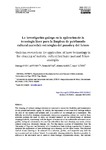Mostrar o rexistro simple do ítem
La investigación gallega en la aplicación de la tecnología láser para la limpieza de patrimonio cultural material: estrategias del pasado y del futuro
| dc.contributor.author | Pozo Antonio, José Santiago | |
| dc.contributor.author | Rivas Brea, Teresa | |
| dc.contributor.author | Ramil, Alberto | |
| dc.contributor.author | López, Ana | |
| dc.date.accessioned | 2024-02-05T16:21:01Z | |
| dc.date.available | 2024-02-05T16:21:01Z | |
| dc.date.issued | 2023-12-22 | |
| dc.identifier.citation | Pozo-Antonio, S., Rivas Brea, T., Ramil , A., & López Díaz, A. J. (2023). Galician research on the application of laser technology in the cleaning of material cultural heritage: past and future strategies. Cadernos do Laboratorio Xeolóxico de Laxe. Revista de Xeoloxía Galega e do Hercínico Peninsular, 45, 17-31. https://doi.org/10.17979/cadlaxe.2023.45.0.9457 | es_ES |
| dc.identifier.issn | 0213-4497 | |
| dc.identifier.other | ISSN-e 2173-6936 | |
| dc.identifier.uri | http://hdl.handle.net/2183/35404 | |
| dc.description.abstract | [Abstract] The cleaning of cultural heritage elements is essential to ensure the durability and transmission of our cultural and artistic legacy. In Galicia, the importance of our stone-built heritage reflects the skill of our masters and artisans and is a symbol of our strength as a community. The difficulty involved in cleaning polymineralic stones such as granites, schists, etc. used on these artworks justifies the need to carry out detailed research on the effectiveness of different cleaning methods, considering both the degree of extraction of the undesirable substance (crust, graffiti, biological colonization, etc.) and the side effects that such cleaning may cause, such as mineral extraction, chromatic changes, etc. For this reason, a group of researchers from the University of Vigo and the University of A Coruña have been working together for 13 years to optimize the application of laser technology as a cleaning tool for these stones. This physical method allows cleaning to be achieved in a selective, gradual, and respectful way with the environment and the workers’ health. A sustainable cleaning method is therefore possible. In addition to the innovative use of lasers to clean heritage polymineralic stones, this Galician research group made progress in this area with the simultaneous application of wavelengths (infrared-1064 nm and ultraviolet-355 nm) and the sequential combination of laser with chemical and mechanical cleaning procedures. These strategies have made it possible to reach high levels of extraction and reduce side effects thanks to the reduction of applied fluence levels. | es_ES |
| dc.description.abstract | [Resumen] La limpieza de elementos del patrimonio cultural es fundamental para asegurar la durabilidad y transmisión de nuestro legado cultural y artístico. En Galicia, la importancia de nuestro patrimonio construido en roca es reflejo de la habilidad de nuestros maestros y artesanos y es un símbolo de nuestra fortaleza como comunidad. La dificultad que entraña la limpieza de rocas poliminerálicas como son los granitos, esquistos, etc. empleadas en estas obras justifica la necesidad de realizar investigaciones pormenorizadas sobre la eficacia de diversos métodos de limpieza considerando tanto el grado de extracción de la sustancia indeseada (costras, grafiti, colonización biológica, etc.) como los efectos colaterales que puedan ocasionar dichas limpiezas, como por ejemplo extracción de minerales, cambios cromáticos, etc. Por este motivo, un grupo de investigadores e investigadoras de la Universidade de Vigo y la Universidade da Coruña trabajan conjuntamente desde hace 13 años para optimizar la aplicación de la tecnología láser como herramienta de limpieza de estas rocas. Este método físico permite alcanzar limpiezas de un modo selectivo, gradual y respetuoso con el medio ambiente y la salud de los trabajadores. Se posibilita por lo tanto un método de limpieza sostenible. Además de la utilización innovadora del láser para limpiar rocas poliminerálicas del patrimonio, este grupo de investigación gallego realizó avances en este ámbito con la aplicación simultánea de longitudes de ondas (infrarroja-1064 nm y ultravioleta- 355 nm) y la combinación secuencial de procedimientos de limpieza láser, químicos y mecánicos. Estas estrategias han permitido alcanzar altos niveles de extracción y reducir los efectos colaterales gracias a la reducción de los niveles de fluencia aplicados. | es_ES |
| dc.description.sponsorship | Xunta de Galicia; ED431F 2022/07 | es_ES |
| dc.description.sponsorship | Todos los coautores agradecen a los proyectos del Ministerio de Ciencia e Innovación PID2021-123395OA-I00 y de la Xunta de Galicia ED431F 2022/07 | es_ES |
| dc.language.iso | spa | es_ES |
| dc.publisher | Universidade da Coruña, Servizo de Publicacións | es_ES |
| dc.relation | info:eu-repo/grantAgreement/AEI/Plan Estatal de Investigación Científica y Técnica y de Innovación 2021-2023/PID2021-123395OA-I00/ES/LIMPIEZA SOSTENIBLE DEL PATRIMONIO PICTORICO: OPTIMIZACION DE LOS PROCESOS DE ABLACION LASER | es_ES |
| dc.relation.uri | https://doi.org/10.17979/cadlaxe.2023.45.0.9457 | es_ES |
| dc.rights | Atribución-CompartirIgual 4.0 Internacional (CC BY-SA) | es_ES |
| dc.rights.uri | http://creativecommons.org/licenses/by-sa/3.0/es/ | * |
| dc.subject | Conservation | es_ES |
| dc.subject | Restoration | es_ES |
| dc.subject | Cultural heritage | es_ES |
| dc.subject | Stone | es_ES |
| dc.subject | Cleaning | es_ES |
| dc.subject | Conservación | es_ES |
| dc.subject | Restauración | es_ES |
| dc.subject | Patrimonio cultural | es_ES |
| dc.subject | Roca | es_ES |
| dc.subject | Limpieza | es_ES |
| dc.title | La investigación gallega en la aplicación de la tecnología láser para la limpieza de patrimonio cultural material: estrategias del pasado y del futuro | es_ES |
| dc.title.alternative | Galician Research on the Application of Laser Technology in the Cleaning of Material Cultural Heritage: Past and Future Strategies | es_ES |
| dc.type | info:eu-repo/semantics/article | es_ES |
| dc.rights.access | info:eu-repo/semantics/openAccess | es_ES |
| UDC.journalTitle | Cadernos do Laboratorio Xeolóxico de Laxe. Revista de Xeoloxía Galega e do Hercínico Peninsular | es_ES |
| UDC.volume | 45 | es_ES |
| UDC.startPage | 17 | es_ES |
| UDC.endPage | 31 | es_ES |






